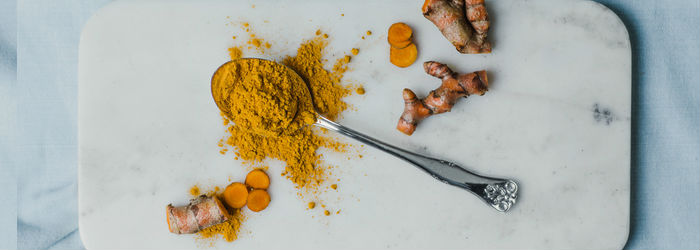Adaptogens to fight winter colds and blues

Adaptogens, or superherbs, are a group of herbs that support and rebalance the body, allowing us to adapt to stressors whether they are physical, environmental or emotional. They have been likened to a thermostat regulating our body, calming us down when we are too stressed and boosting our energy when we are depleted, but without exhausting or draining our adrenals. Herbalists use the term ‘vital force’ to explain the amount of energy within the tissues and organs of the body, and when this vitality or vital force becomes depleted through stress and exhaustion you may start to feel unwell and overwhelmed. Adaptogens are powerful supportive herbs that can help rejuvenate and support this vital force, and in doing so they can help protect the body from disease and stress.
Rachel Landon, author of Superherbs, gives her top suggestions for the best way to use adaptogens to fight off those winter colds and blues.
TURMERIC
Recently the medicinal properties of turmeric have come to light, and it is now being touted as the superherb for our everyday use. It is in fact a really accessible adaptogen that can be bought fresh in most health- food shops (and ground in every supermarket) and easily added to your daily routine.
In India and southern Asia turmeric has been used for thousands of years in cooking. It is eaten much like ginger, either cooked or eaten raw, although it is less fibrous than ginger. With its warming, stimulating properties which affect the whole digestive system, the fresh root can be chopped, or ground into a paste. Within Ayurvedic medicine it is used for warming the whole body system, improving not only digestion but arthritic joints and muscular pains.
A Winter Soothing Warmer.
Combine the following ingredients for a traditional cup of exotic golden milk.
Serves 1
1 teaspoon of powdered turmeric
1 teaspoon of almond oil
A splash of clear honey
200ml of almond milk, or milk of your choice
Mix the turmeric in a saucepan with the oil and the honey
over a low heat, until the honey melts a little to form a paste,
stirring with a whisk. Then slowly mix in a little bit of milk at
a time, continuously stirring until all the milk has been added
and the turmeric and honey have been mixed completely into
the milk.
ROSE HIPS
Rose hips are an impressive immune- system booster. I use these natural jewels in a syrup during our long damp winter months here in England, when I feel there is a need for extra protection from recurring colds, flu and tummy bugs. Hips contain one of the highest natural plant sources of vitamin C available – as much as 20 per cent more than citrus fruit, weight for weight. And it’s much easier for the body to assimilate than synthetic vitamin C supplements commonly used to build resistance over the winter period. Rose hips support immunity, they detox the system, and they are cooling, making them a good remedy for flu and colds. To harvest the hips, wait until after the first frosts, when the hips are a vibrant, beautiful, shiny ripe red – then they’re ready for picking. Please note that the traditional cultivated rose hips from roses found in parks and gardens have a lot fewer medicinal and nutritional benefits than wild roses, and often have been sprayed with pesticides.
Rose Hip Soup
This is a Swedish favourite called Nyponsoppa which dates back to when foraging for rose hips was done in the long, harsh winter months, before foods became available out of season, flown in from countries around the world. Swedes would collect the rose hips and prepare this soup as a starter or dessert to ensure they had the essential nutrients they needed to keep their immune systems strong.
Serves 2
About 5 cups of ripe rose hips
8 cups of filtered water
1/2 cup of granulated sugar
1 teaspoon of cornflour
Cut each hip in half and remove the hairs and seeds.
Put the prepared hips in a saucepan with the water. Bring to
the boil and then simmer for 45 minutes. Cook until the hips
are soft, giving the liquid a chance to reduce.
Take off the heat and put the liquid into a food processor or
blender and pulse a few times. Strain the mashed hips through
muslin or a fine sieve back into the pan. Add the sugar and put
the pan on to simmer again. Discard the strained pulp.
Blend the cornflour with a little hot water to form a soft paste,
and add the paste a little at a time to the pan, stirring continuously
until the soup thickens slightly.
Serve hot or cold. I like to add a sprig of fresh mint, basil or
chervil to garnish. Traditionally a little crème fraiche or cream
was added.
RHODIOLA
Rhodiola is a superherb that helps support us through environmental, physical and emotional stress. It’s thought to be superior to ginseng when suffering extreme stress, and it helps us metabolise serotonin, the ‘happy hormone’. The Mongolians used rhodiola in the treatment of tuberculosis, pneumonia and cancer, and for preventing illness in the long
winter months. Tibetan monks took a decoction to help calm their mind for meditation, and Sherpas used the root to help oxygenate the blood while trekking at high altitudes.
Rhodiola Latte
This caffeine- free latte makes a warming beverage at any time of day. Bee pollen gives an added antioxidant hit.
2 teaspoons of rhodiola powder
1 teaspoon of turmeric powder
1 cup of almond milk (or milk of choice)
1 dessertspoon of good quality honey
2 teaspoons of bee pollen
Place the rhodiola and turmeric in a mug. Simmer the milk and
pour a little into the bottom of the mug, whisking with a fork
or whisk so the herbs blend. Add the remaining milk and then
sprinkle a couple of teaspoons of bee pollen and honey for flavour
and an extra health boost.
HAWTHORN
The hawthorn provides nourishment and medicinal properties the whole year round, with its young leaves and blossoms in spring and its berries in the autumn and winter months.
Hawthorn and Cinnamon Liqueur
A lovely immune- boosting, heart- warming snifter to get you through the winter months.
A cup of hawthorn berries (destalked, cleaned and debugged)
1 nutmeg, freshly grated
1 cinnamon stick
Peel of 1 orange (eat the orange; we’re using just the peel)
1 cup of honey
500ml of good quality brandy
Put the hawthorn berries, nutmeg, cinnamon, orange peel
and honey in a large sterilised jar or bottle, and cover with the
brandy, making sure all the ingredients are submerged. Label
and date, and leave in a cool dark place for around two years or
more – depending if you’re patient enough to wait!
Rachel Landon is a former model and qualified with honours in Naturopathy Herbal Medicine and Iridology. She now has her own practice working with patients holistically, in order to support the body and immune system with bespoke supplements, herbs and nutritional plans. She is also a fully trained yoga therapist for children with learning and social difficulties working in schools around London and has taught herbal salve and formula courses at The Life Centre using easy-to-find local herbs.
She has written articles for Get The Gloss, Neal’s Yard Remedies, Thandie Kay blog, Stylist magazine France and Your Fitness magazine.







